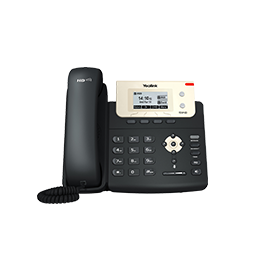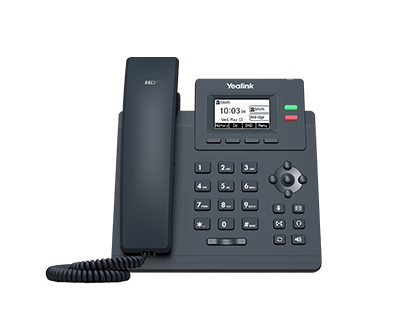Yealink T21P E2

This model is automatically provisioned towards Telavox, which means that no manual configuration is required. This hardware only needs power and a network connection to work properly with the Telavox telephony (provided it is connected to a user/extension).
Provisioning parameters that are supported on Yealink T21P E2:
- Automatic Firmware Upgrade
- Call functionality
- MWI (Message Waiting Indicator)
- BLF (Busy Lamp Field)
- Remote Phonebook
- Timezone
- Language
Troubleshooting
What to do, when...
The phone does not turn on
- Ensure the power supply is connected properly.
- If using PoE (Power over Ethernet), confirm that the Ethernet cable is connected to a PoE-enabled switch or injector.
- Try using a different power adapter or Ethernet cable to rule out issues with the current cable or power source.
There is no dial tone
- Check the handset connection. Make sure it is securely connected to the handset port.
- Ensure the phone is registered with the VoIP server (check the screen for a registration status).
- Restart the phone by unplugging the power, waiting a few seconds, and then plugging it back in.
The phone is not registering
- Confirm that the network cable is properly connected and that the network port is active.
- Ensure the network settings are correct. You may need to check IP address, subnet mask, gateway, and DNS settings under the Network menu.
- Verify SIP server settings such as the server address, username, and password.
- Restart the phone after checking and updating settings.
The audio quality is poor
- Check the network connection for issues (replace cables if needed).
- Make sure other network-intensive activities are not causing congestion.
- Enable Quality of Service (QoS) settings on your router to prioritize voice traffic.
- Go to Menu > Features > Audio and adjust the echo cancellation and other audio settings.
There are display issues - the screen is blank or frozen
- Restart the phone.
- If the screen is blank but the phone has power, increase the brightness under Menu > Settings > Display.
- If the screen remains unresponsive, perform a factory reset.
Calls cannot be made or received
- Ensure the phone is registered with the VoIP server.
- Verify SIP account credentials and confirm with your service provider that there are no account issues.
- Check if call forwarding or Do Not Disturb (DND) is enabled under Menu > Features and disable if necessary.
- Restart the phone and the network equipment.
There is one-way audio (you can hear the other party, but they cannot hear you and vice versa)
- Check NAT settings and configure them appropriately under Menu > Network > Advanced.
- Confirm firewall settings on your network and adjust them to allow VoIP traffic.
- Ensure that SIP ALG is disabled on your router, as it can sometimes interfere with VoIP traffic.
The phone does not connect to the network
- Confirm that the Ethernet cable is securely connected and that the port is active.
- Check the network settings, including DHCP (if used), or set a static IP manually under Menu > Network > WAN Port.
- Verify if other devices can connect to the same network to rule out network issues.
- Restart both the phone and network equipment (e.g., router, switch).
There are firmware update issues
- Download the latest firmware from Yealink’s official website and save it to your computer.
- Access the phone’s web interface by entering its IP address into a browser.
- Go to Upgrade > Firmware Update, select the firmware file, and upload it.
- Do not interrupt the power supply or network connection during the update process.
Good to know...
How do I do a factory reset?
- Press and hold the OK button on the phone for 10 seconds until the reset screen appears.
- Select OK to confirm the factory reset.
- Be aware that a factory reset will erase all custom configurations, including SIP account settings, network configurations, and custom settings.
How do I access the web interface?
- Find the phone’s IP address by going to Menu > Status on the phone.
- Enter the IP address in a web browser.
- Log in using the default credentials (usually admin for both username and password, unless changed).
- You can change network settings, update firmware, configure SIP accounts, and more through the web interface.
It is also good to check if you have any call routings active on the terminal's number or call blocks - as well as if there are any settings related to your incoming calls.
DeleteYealink T31G

This model is automatically provisioned towards Telavox, which means that no manual configuration is required. This hardware only needs power and a network connection to work properly with the Telavox telephony (provided it is connected to a user/extension).
Provisioning parameters that are supported on Yealink T31G:
- Automatic Firmware Upgrade
- Call functionality
- MWI (Message Waiting Indicator)
- BLF (Busy Lamp Field)
- Remote Phonebook
- Timezone
- Language
Troubleshooting
What to do, when...
The phone does not turn on
- Ensure the power adapter is securely connected, or if using Power over Ethernet (PoE), make sure the Ethernet cable is connected to a PoE-enabled switch or injector.
- If using an adapter, try using a different power outlet or adapter to eliminate issues with the power supply.
- For PoE, test with a different Ethernet cable or port to confirm functionality.
There is no dial tone
- Verify the handset and cord are securely connected to the correct ports.
- Check if the phone is registered with the SIP server. The registration status should be displayed on the phone screen.
- If unregistered, troubleshoot the network connection and SIP account settings (see below).
The phone is not registering
- Confirm the network cable is connected properly and that the network port is active.
- Check network settings: go to Menu > Status to view IP address and network connection status.
- Verify the SIP account settings (e.g., server address, username, password) under Menu > Settings > Advanced Settings > Account.
- Restart the phone after confirming settings.
The audio quality is poor
- Ensure a stable network connection by testing with a different Ethernet cable if needed.
- Check for network congestion and try to limit other bandwidth-heavy activities.
- Enable Quality of Service (QoS) on the router to prioritize voice traffic.
- Adjust audio settings in the phone’s web interface under Settings > Audio.
There are display issues - the screen is blank or frozen
- Ensure the phone has power and the screen brightness is adjusted properly under Menu > Basic Settings > Display.
- Restart the phone by unplugging it and plugging it back in after a few seconds.
- If the screen remains unresponsive, consider performing a factory reset (see below).
Calls cannot be made or received
- Confirm that the phone is registered with the SIP server (see above).
- Check for any Do Not Disturb (DND) settings under Menu > Features and disable it if enabled.
- Verify SIP server connectivity and account status with your service provider.
- Restart both the phone and network equipment (router, switch, etc.).
There is one-way audio (you can hear the other party, but they cannot hear you and vice versa)
- Check NAT (Network Address Translation) settings in the phone’s web interface under Network > Advanced Settings and configure them if needed.
- Disable SIP ALG (Application Layer Gateway) on your router, as it can interfere with audio transmission.
- Check firewall settings and ensure the necessary VoIP ports are open.
The phone does not connect to the network
- Make sure the Ethernet cable is securely connected to both the phone and the network switch or router.
- Go to Menu > Status > Network to check the phone’s IP address. If no IP address is assigned, check your DHCP settings, or set a static IP manually.
- Test with another device on the same network port to verify network functionality.
- Restart the phone and network devices (e.g., router, switch) to reset the network connection.
There are firmware update issues
- Download the latest firmware for the Yealink T31G from Yealink’s official website and save it to your computer.
- Access the phone’s web interface by entering its IP address into a web browser.
- Navigate to Upgrade > Firmware Update, select the firmware file, and upload it to the phone.
- Do not interrupt the update process to avoid issues.
Good to know...
How do I do a factory reset?
- Press and hold the OK button on the phone for 10 seconds until a reset prompt appears.
- Confirm the reset by selecting OK.
- Note that a factory reset will erase all custom configurations, including SIP account and network settings.
How do I access the web interface?
- Go to Menu > Status > Network to find the phone’s IP address.
- Enter the IP address into a web browser to access the web interface.
- Use the default username and password (usually
adminfor both) to log in, unless they’ve been changed. - From the web interface, you can manage network settings, SIP accounts, firmware updates, and more.
It is also good to check if you have any call routings active on the terminal's number or call blocks - as well as if there are any settings related to your incoming calls.
Delete